INTRODUCTION
- Humans are sexually reproducing viviparous organisms
- Reproductive system is composed of
(i) Primary sex organs– Site for gamete formation
(ii) External genitalia– Involved in copulation - Accessory ducts of human reproduction-
- Accessory glands-Facilitate transport of gametes
THE MALE REPRODUCTIVE SYSTEM
- Location:- Pelvic region
- Testes: The primary male reproductive organs responsible for producing sperm and testosterone.
- Epididymis: A coiled tube located on the surface of each testis where sperm mature and are stored.
- Vas Deferens: Long, muscular tubes that transport mature sperm from the epididymis to the ejaculatory duct.
- Seminal Vesicles: Glandular structures that secrete a fluid rich in fructose and other nutrients to nourish sperm.
- Prostate Gland: A gland that secretes a milky, alkaline fluid that helps neutralize acidic vaginal secretions and enhances sperm motility.
- Bulbourethral Glands (Cowper’s Glands): Glands that secrete a clear, viscous fluid that lubricates the urethra and neutralizes any remaining acidic urine.
Physiology:
- Spermatogenesis: The process of sperm production that occurs in the seminiferous tubules of the testes.
- Hormonal Regulation: The hypothalamus releases gonadotropin-releasing hormone (GnRH), which stimulates the anterior pituitary gland to secrete luteinizing hormone (LH) and follicle-stimulating hormone (FSH). LH stimulates the interstitial cells of the testes to produce testosterone, while FSH stimulates spermatogenesis.
- Ejaculation: The process by which sperm are expelled from the male reproductive tract. It is controlled by a complex interplay of nervous system signals and involves the contraction of various muscles, including those of the vas deferens, seminal vesicles, and prostate gland.
Function:
- Sperm Production: The testes continuously produce sperm through spermatogenesis, ensuring a constant supply of male gametes for fertilization.
- Hormone Secretion: The testes secrete testosterone, the primary male sex hormone responsible for the development of male secondary sexual characteristics, sperm production, and libido.
- Fertilization: Sperm are ejaculated into the female reproductive tract during sexual intercourse and may fertilize an egg if present, initiating the process of embryonic development.
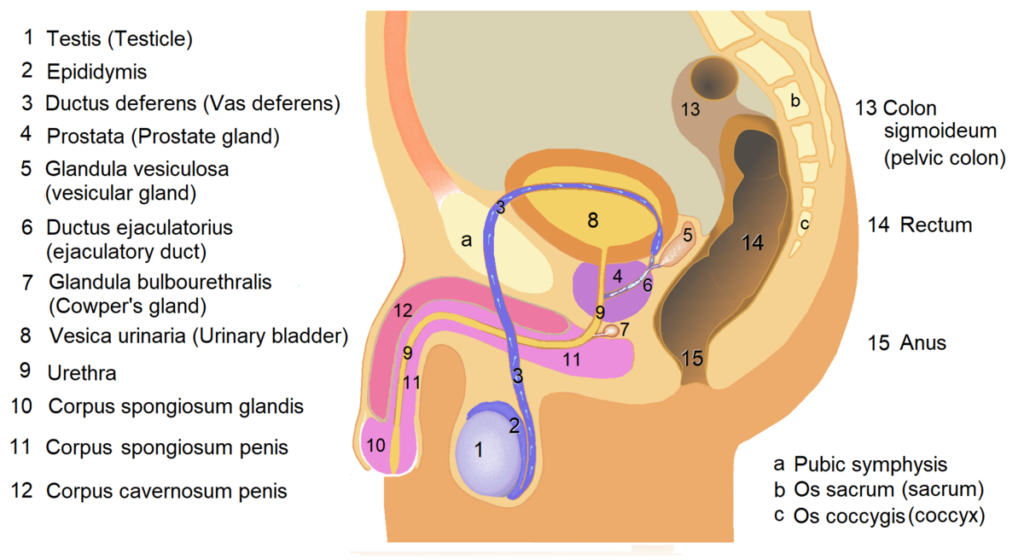
FEMALE REPRODUCTIVE SYSTEM
Anatomy:
- Ovaries: The guardians of life, nestled within the pelvis, where the precious ova, the seeds of future generations, are nurtured and ripened.
- Fallopian Tubes: Delicate passages, akin to gentle hands, guiding the ovum on its journey, where the miracle of fertilization may unfold.
- Uterus: The cradle of existence, a sacred chamber, where the embryo is embraced and nurtured with tender care, awaiting the moment of birth.
- Cervix: The vigilant gatekeeper, standing firm at the entrance to the uterus, protecting it from harm while allowing the passage of life during childbirth.
- Vagina: The gateway to womanhood, a passage of love and intimacy, where life begins its journey into the world.
Physiology:
- Ovulation: A celestial dance of hormones orchestrating the release of the ovum from the ovary, ready to embark on its quest for union.
- Menstruation: A monthly symphony of renewal, shedding the uterine lining to make way for new beginnings, a testament to the cyclical nature of life.
- Fertilization: A divine union of egg and sperm, a cosmic embrace, heralding the dawn of new life and the continuation of the human saga.
- Pregnancy: A miraculous transformation, where the uterus becomes a sanctuary, nurturing the growing embryo with unwavering devotion until the moment of birth.
Note:- Uterine wall consists of three layers:-
(i) Endometrium – Lines lumen, glandular and undergoes cyclic changes during menstruation
(ii) Myometrium– Thick layer of smooth muscles that show strong contraction during delivery.
(iii) Perimetrium- External thin membraneExternal Genitalia of Female:-
Parts Features
>Mons pubis– Cushion of fatty tissue covered by skin and pubic hair.
>Labia majora– Fleshy folds of tissue that extend down from mons pubis and surround the vaginal opening.
>Labia minora– Paired folds of tissue under the labia majora.
>Clitoris– Tiny finger like structure which lies at the upper junction of labia minora above the urethral opening.
>Hymen– • Membrane that partially covers the opening of vagina
• Can be torn while-sudden jolt/fall, horse riding,
cycling, insertion of vaginal tampon
•May or may not be torn during the first coitus so its presence or absence is not reliable indicator of virginity or sexual experience
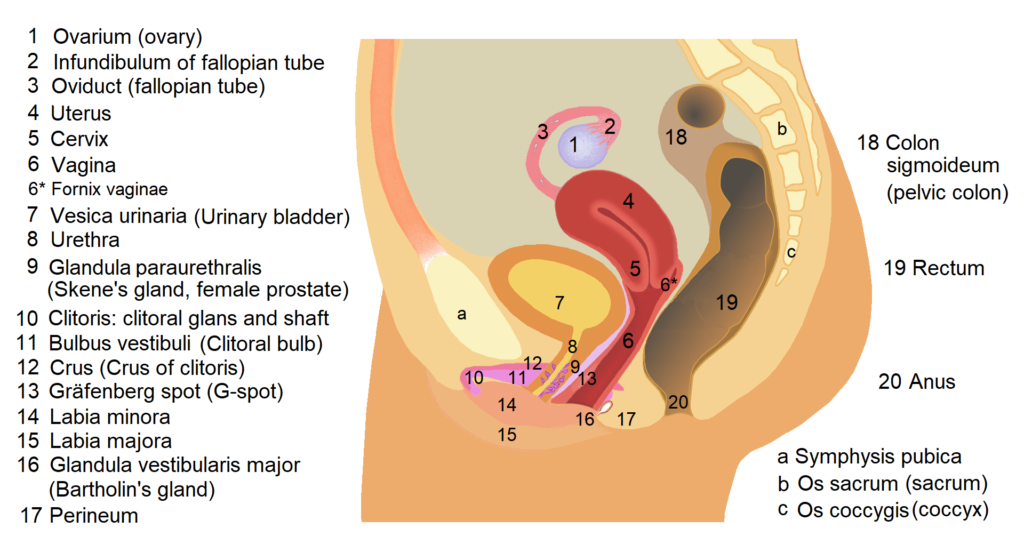
HUMAN REPRODUCTION
PRIMARY SEX ORGANS
Parameters Male Female
Organ Testis Ovary
Number 2 2
Shape Oval Almond
Location outside abdominal cavity Lower abdomen,one on each
in a pouch called scrotum side
Dimensions Length 4-5 cm, width 2-3 cm Length 2 to 4 cm
Covering Dense connective tissue Thin epithelium (outermost)
(outermost)
Functions Sperm formation, synthesise Ova formation, synthesise
steroidal testicular hormones steroidal ovarian hormones
like androgens like estrogen and progesterone
Compartments 250 testicular lobules Peripheral cortex and inner
medulla zones in ovarian
• 1-3 coiled seminiferous Stroma have follicles in
tubules/lobule various developing stages
• Cells lining the seminiferous tubules Functions
(a) Male germ cells/spermatogonia Sperm formation
(b) Sertoli cells Provide nutrition to the gem cells
Note:-
• Scrotum helps in maintaining the temperature 2 to 2.5° lower than body temperature, necessary for spermatogenesis.
• Interstital spaces outside seminiferous tubules contain immunocompetent cells and leydig cells
• Ovary is connected to pelvic wall and uterus by ligaments.
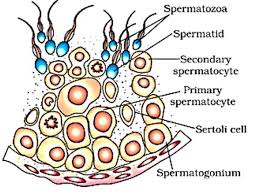
GAMETOGENESIS
- PROCESS OF GAMETE FORMATION
Parameters Male Female
Term- Spermatgenesis Oogenesis
Process begins– At puberty During embryonic development
Ploidy &
chromosome
number per cell
2n=46 Male germ cells/ Female mother cells/
Spermatogonia Oogonia
↓ Mitosis differentiation ↓
2n=46 primary spermatocytes Primary oocyres
⇓ Periodic Meiosis I Birth
Puberty ⇓
n= 23 Secondary spermatocytes 1st polar body Secondary oocytes
⇓ ⇓ ⇓
n= 23 Spermatids 2nd polar body Ovum
Spermiogenesis ↓ ↓ ↓ ↓
n= 23 Sperms
Spermination ↓
∗ 2n = diploid Released from
∗ n = haploid seminiferous
tubules
Primary oocytes
↓
In fetus
(arrested at prophase I)
↓
Puberty→Follicles primary
↓
Secondary
↓
Tertiary
↓
Graafian/mature
↓
OvulationCharacteristics:-
• Single layer of granulosa cells
• More layers of granulosa cells and a new theca layer.
• Completion of meiosis I
(Rduction division)
• Fluid filled cavity antrum and theca layers are organised into external and internal layers.
• Secondary oocyte forms acellular zona pellucida around it.Note:-
• No more oogonia are formed added after birth
• During the embryonic development, a couple of million gamete mother cells (oogonia) are formed within each fetal ovary.
• A large number of follicles degenerate from birthto puberty so only 60,000-80,000 primary follicles are left in each ovary at puberty.
• Meiosis in oogenesis results in unequal sized cells and the secondary oocyte retains bulk of the nutrient rich cytoplasm of the primary oocyte.
• Fate of polar body is not certain. - Spermiogenesis is transformation of spermatids to sperms and sperm head is embedded in Setoli cells
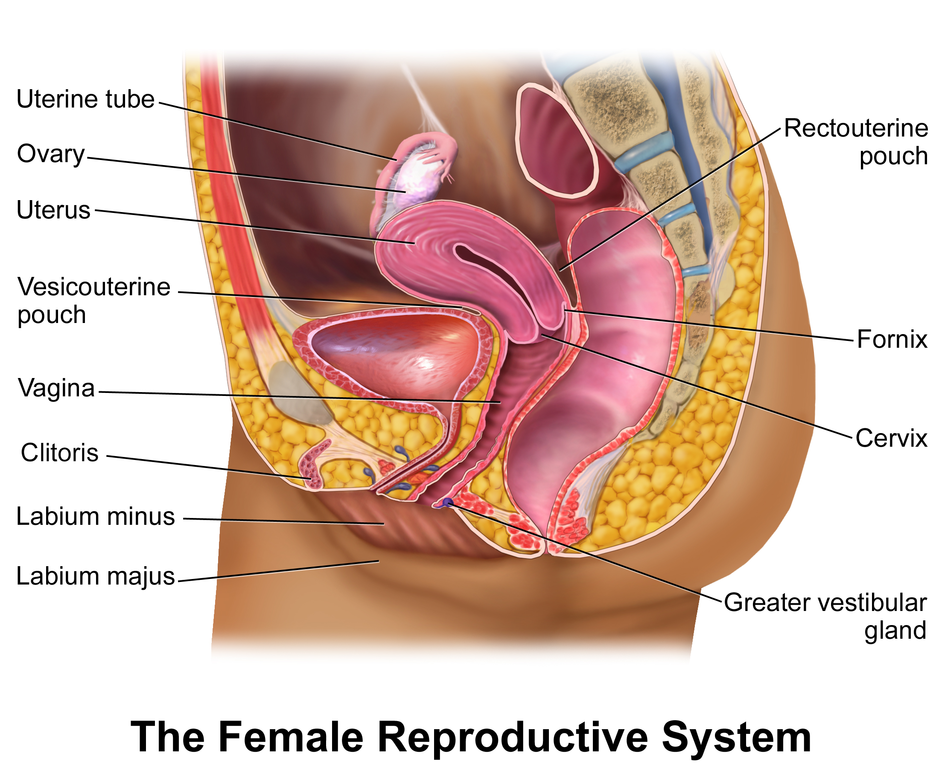
SEMEN
- Secretions of epididymis and vas deferens are essential for maturation and motility of sperms.
- Male ejaculates about 220-300 million sperms during a coitus.
- For normal fertility:-
• 60% sperms must have normal shape and size
• 40% of 60% sperms must show vigorous motility
HORMONAL REGULATION IN MALES
Hypothalamus
↓ secretes
GnRH (significant amount)
↓ targets
Anterior pituitary
↓secretes
Gonadotropins
|_________________|
↓Seminiferous ↓
FSH tubules LH
acts on ↓ ↓
Sertoli Leydig/interstitial
cells cells
↓ Synthesise & release ↓
Some factors Androgens/Testicular
hormoes
↓ Stimulate ↓
Spermiogenesis Spermatogenesis
• The function of male sex accessory ducts and glands are maintained by the testicular hormones (androgens).
STRUCTURE OF GAMETES
SPERM
- Main parts
> Acrpsome:- Cap like structure filled with enzymes, help in fertilization.
> Nucleus (n) Elongated.
> Mitochondria- Provide energy source for swimming/ movement of tail.
> Tail:- Facilitate sperm motility which is essential for fertilization.ovum
THE OVUM:- The ovum, also known as the egg cell or oocyte, stands as a testament to the beauty and complexity of life’s creation. As the female gamete, the ovum plays a pivotal role in the process of fertilization and the initiation of new life.
STRUCTURE: The ovum is a specialized cell characterized by its large size and distinctive structure. It is typically spherical or ovoid in shape, with a diameter of approximately 0.1 millimeters. Surrounding the ovum is a protective layer known as the zona pellucida, which helps facilitate the process of fertilization. Beneath the zona pellucida lies the cytoplasm, which contains various organelles necessary for the metabolic processes of the cell. At the center of the ovum is the nucleus, which houses the genetic material in the form of chromosomes.
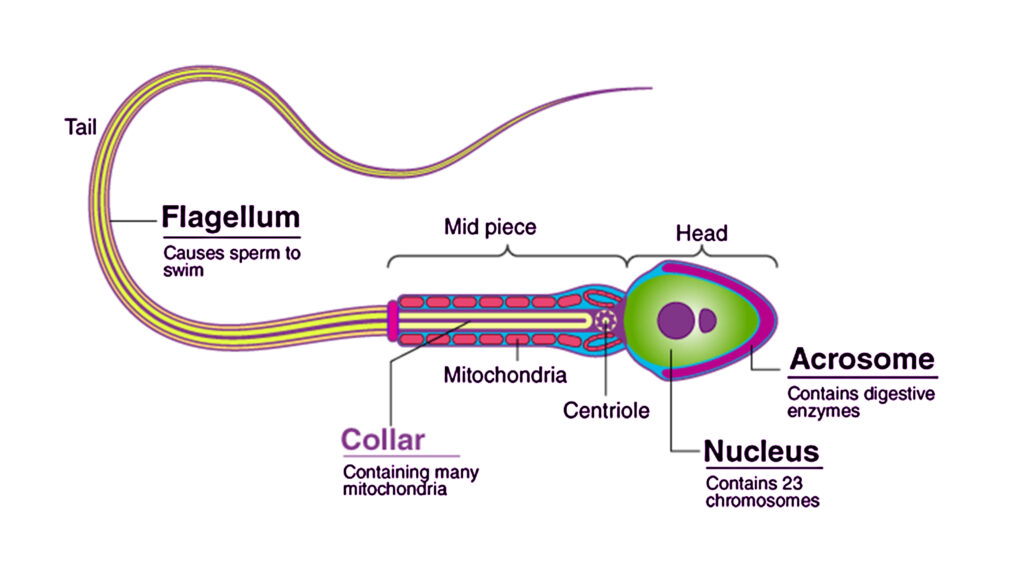
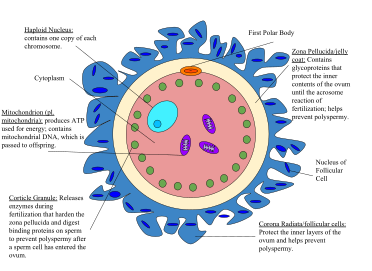
HORMONAL REGULATION IN FEMALES
AND MENSTRUAL CYCLE
- The cycle of events starting from one menstruation till the next one is termed menstrual cycle.
- Characteristic of female primates
(i) Monkeys
(ii) Apes
(iii) Humans - Begins at puberty- menarche
- Ceases around 50 years- menopause– Reproductive phase
- Cycle occurs if ovum remains unfertilized
- Lack of cycle may be an indication of – Pregnancy, stress, poor health etc.
- Average duration in humans= 28/29 days.
MENSTRUAL CYCLE
- Changes in the ovary and the uterus are induced by changes in the levels of pituitary and ovarian hormones.
Phase Duration Hormones & Events Events in
their effects in ovary uterus
Menstrual 3-5 days Drastic decline Corpus luteum Breakdown of
in progesterone degenerates endometrial
lining and its
blood vessels
which forms
liquid that
comes out
through vagina
constituting
menstrual flow
Follicular Variable Gradual increase Primary Endometrim
or in FSH and LH follicle regenerates
proliferative that stimulate gradually through
phase secretion of matures proliferation
estrogen from to Graafian
follicles follicle
Ovulation 14th day FSH and LH Rupture of Proliferation of
(Middle of at peak, Graafian endometrium
cycle) (LH surge) follicle and continues
release of
only one
ovum/cycle
Luteal Fixed Secretion of Remnants of Endometrium
or (14 days) progesterone the Graafian is maintained
Secretory and estrogen follicle if ovum
transforms into remains
corpus luteum unfertilized,
endometrium
is sloughed
of, marking
a new cycle
HORMONAL REGULATION IN FEMALES
AND MENSTRUAL CYCLE
- Maintenance of hygiene and sanitation during menstruation is very important.
- Take bath and clean yourself regularly use sanitary napkins/clean home made pads.
- Change sanitary pads after every 4-5 hrs.
- Dispose of used sanitary napkins properly by wrapping it in used paper.
- After handling the napkin wash hands with soap.
Note:-
• If an ovum gets fertilized, endometrium is maintained by progesterone
necessary for implantation and other events of pregnancy.
• During pregnancy all events of menstrual cycle stop.
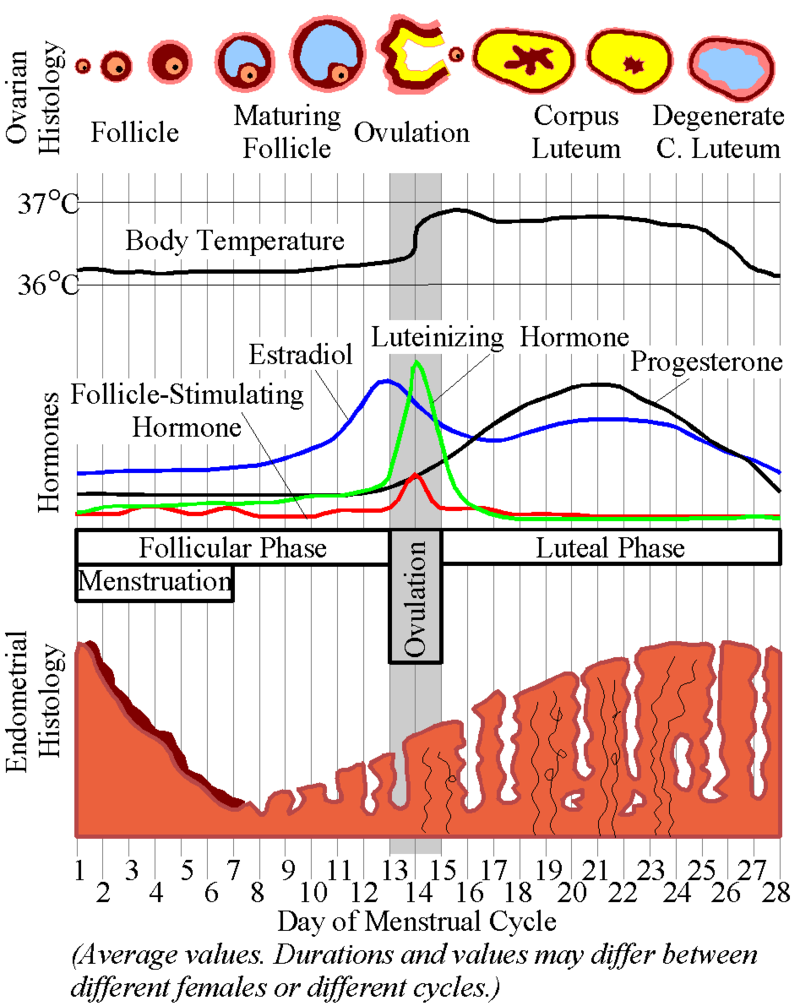
- Human reproduction is undeniably a biological process, but many cultures and belief systems also attribute spiritual significance to the creation of new life. This intersection of biology and spirituality adds depth to our understanding of reproduction.
- While reproduction is often discussed in biological terms, the emotional and psychological aspects play a significant role. Factors such as desire for parenthood, infertility struggles, and the bond between parents and children profoundly influence the reproductive journey.
- Comprehensive reproductive health education empowers individuals to make informed decisions about their bodies, sexuality, and family planning. By promoting awareness and access to reproductive healthcare, it contributes to improved well-being and autonomy.
- Reproduction is often discussed within a heteronormative framework, but diverse gender identities and sexual orientations challenge these assumptions. Recognizing the experiences of LGBTQ+ individuals in reproductive healthcare fosters inclusivity and affirmation.
- Indigenous cultures around the world possess rich traditions and knowledge systems related to reproduction and environmental sustainability. Drawing upon indigenous wisdom offers valuable insights into holistic approaches to reproduction and interconnectedness with the natural world.
1 thought on “Human Reproduction Class 12”